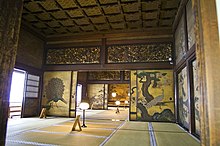Nishi Hongan-ji
The Nishi Hongan-ji ( Japanese 西 本 願 寺 ) is the main temple of the Honganji branch of the Buddhist Jōdo Shinshū school. Its formal temple name (sango) is Ryūkokusan ( 龍谷 山 ). The temple is located in the Shimogyō-ku district of Kyoto and is a World Heritage Site of the city.
About history
After Toyotomi Hideyoshi had driven the followers of the Jōdo Shinshū direction from their temple mount in Osaka, he offered them a place in Kyoto in 1591. The first buildings were lost in a fire, so that the current complex dates from the 17th century and beyond. In the dispute over the successor to the abbot, Tokugawa Ieyasu made a plot of land available for the construction of another Hongan-ji in Kyoto, which is called Higashi Hongan-ji to distinguish it. Onishi and Ohigashi are common short forms , also with the addition -san (for mountain = temple).
The attachment
(⦿ = national treasure , ◎ = important cultural asset of Japan )
Places of worship
If you enter the temple complex over a bridge from the west through the Goeidō gate, you have the large Goei-dō ( 御 影 堂 , founder hall, ⦿) or Daishidō (大師 堂) in front of you. It dates from 1636, its front in north-south direction is 62 m long, its depth is 48 m, its height 29 m. As usual, the high roof is designed as a hipped foot roof ( irimoya ). There is a large ginkgo tree between the entrance gate and the building.
On the right, connected by a corridor, is the Amida-dō ( 阿 弥陀 Am, Amidahalle, ⦿) or Hondō (本 堂). It dates from 1760, its front in north-south direction is 45 m long, its depth is 42 m, its height 25 m. The building also has a hip roof. This area is accessible through the Amidadō-mon entrance gate.
A magnificent gate in the Chinese style ( 唐門 , karamon , ⦿) is set into the south wall, but it is not passable. It is said to have been brought here from Fushimi Castle . Because it is so richly decorated that you can look at it from morning to evening, it is nicknamed the "evening sun gate" ( Hikure-mon ).
Abbot quarters
The large abbot's quarter, called Daishoin (大 書院) here, adjoins the places of prayer in the southwest. It is not open to the public.
- The abbot's large reception hall (Taimenjo (対 面 所) or Kō-no-ma (鴻 の 間)) is 203 tatami in size, with the room having three levels, gedan , jōdan and jōjōdan , with the top tier reserved for the abbot is. This hall includes wall shelves (chigaidana) , a study corner (tsuke-shoin) , the quick-opening side doors (chōdai-gamae) , all together an excellent example of the shoin style. The wall paintings come from a representative of the Kanō school , Watanabe Ryōkei († 1645).
- Sparrows room
- Wild geese room
- Chrysanthemum room
- Study room Shiro-shoin ( 白 書院 )
- Study room Kuros-hoin ( 黒 書院 )
- Second Nō stage
- The northern Nō stage dates from 1581 and was donated to the temple. It is the oldest surviving Nō stage in Japan and is registered as a national treasure.
- From Shiro-shoin you can see the small garden Tiger Gorge ( 虎 渓 の 庭 , Kokei no Niwa ). It is executed in the Kare-san-sui style and uses the gable of the founder's hall as a mountain in a "borrowed landscape" (借 景, shakkei). - One looks out over the garden from the eastern corridor, the box ceiling of which is decorated with painted open books. In the middle of the corridor, a painted cat keeps watch to prevent mice from eating.
- Tiger room (虎 の 間, Tora-no-ma) and 11 wave room (浪 の 間, Nami-no-ma) are painted by Kanō Eitoku .
Tekisuien
The small garden complex Tekisuien (滴翠 園) in the southeast of the temple area houses the three-storey "Flying Cloud Pavilion" (飛雲 閣, Hiunkaku, ⦿) behind a pond. The pavilion was originally built for Hideyoshi's residence “Jurakudai” in Kyoto, where it was completely surrounded by water. He was probably moved here around 1610 and is also surrounded by water here.
The building is covered with thin shingles (kokera-buki), whereby the roof is varied with different gable and roof shapes such as kara-hafu, irimoya .
On the ground floor there are rooms like Shokadono and Hakkei-no-ma, there is also a dock for boats and a steam bath (okakudai). The second floor is occupied by the "poet room" (Kasen-no-ma), which is decorated with the 36 poets . The third level is formed by the Tekiseirō roof house, from which the stars can be viewed. - There is also a bell tower (shōrō) of the temple in one corner of the garden, somewhat unusual.
Temple treasures
National treasures: Two picture scrolls with the founder of the Jodo school Shinran and companion. (Kamakura period) and scroll of the 36 poets (Heian period) Significant cultural assets: scrolls, documents and a bronze mirror (Heian period).
Remarks
- ↑ There is now the Osaka Castle, built by Hideyoshi.
- ↑ In the Royal Botanic Gardens (Kew) there is a scaled-down replica.
- ↑ The name refers to a valley in the Chinese province of Jiangxi.
literature
- Honganji (Ed.): Hongwanji , Honganji shuppan-sha, 2012. ISBN 978-4-89416-972-2 . 44 pp.
- Yamamoto, Jirō: Kyoto-fu no rekishi sampo (jo). Yamakawa Shuppan, 1999. ISBN 978-4-634-29260-4 .
Web links
- Official website - Japanese and English
- Nishi Hongan-ji Temple at Culture-in-Asia: Part 1 with description - Part 2 - Part 3 - Part 4 - Part 5 - Part 6
Coordinates: 34 ° 59 ′ 30.4 " N , 135 ° 45 ′ 6.1" E





